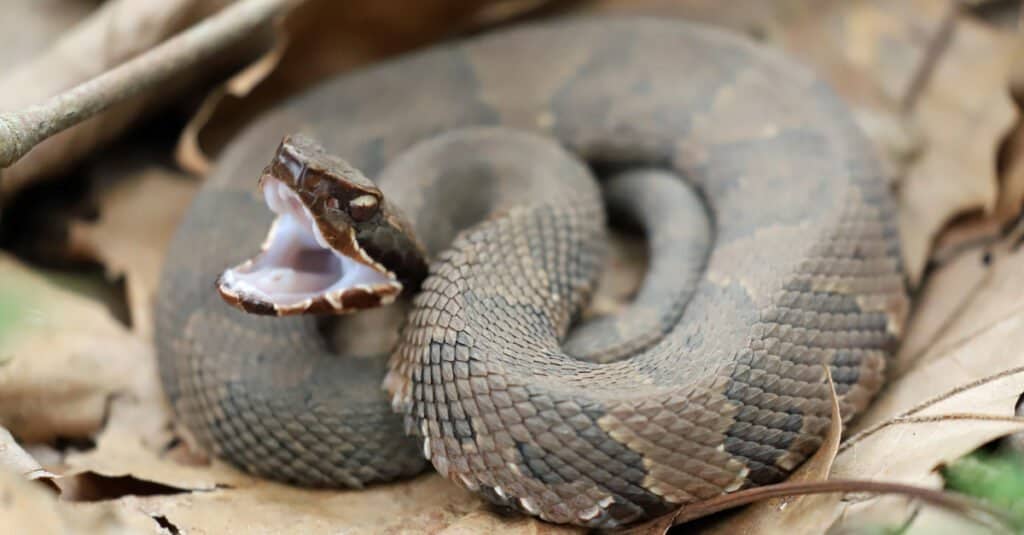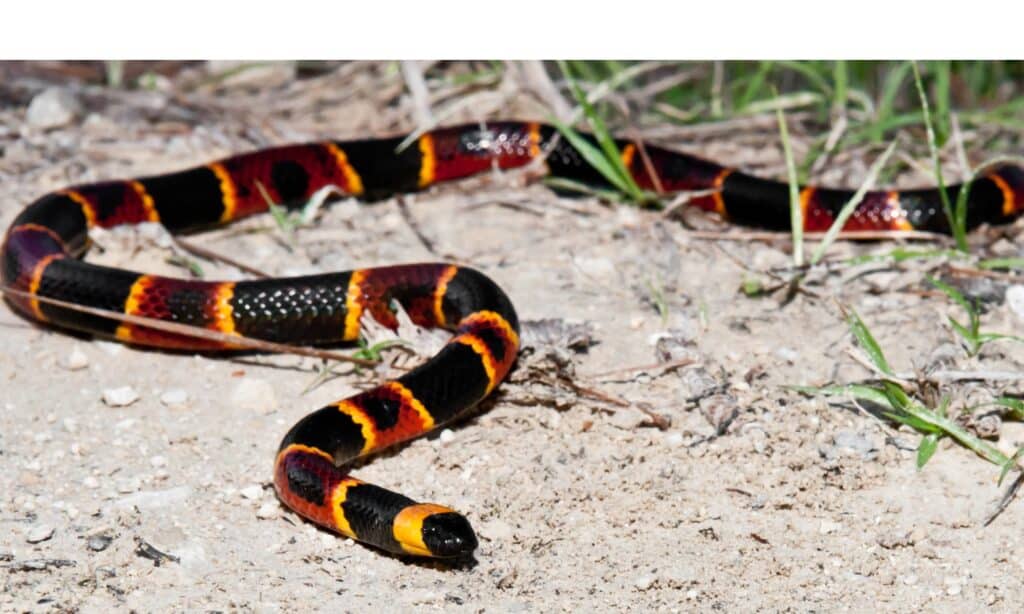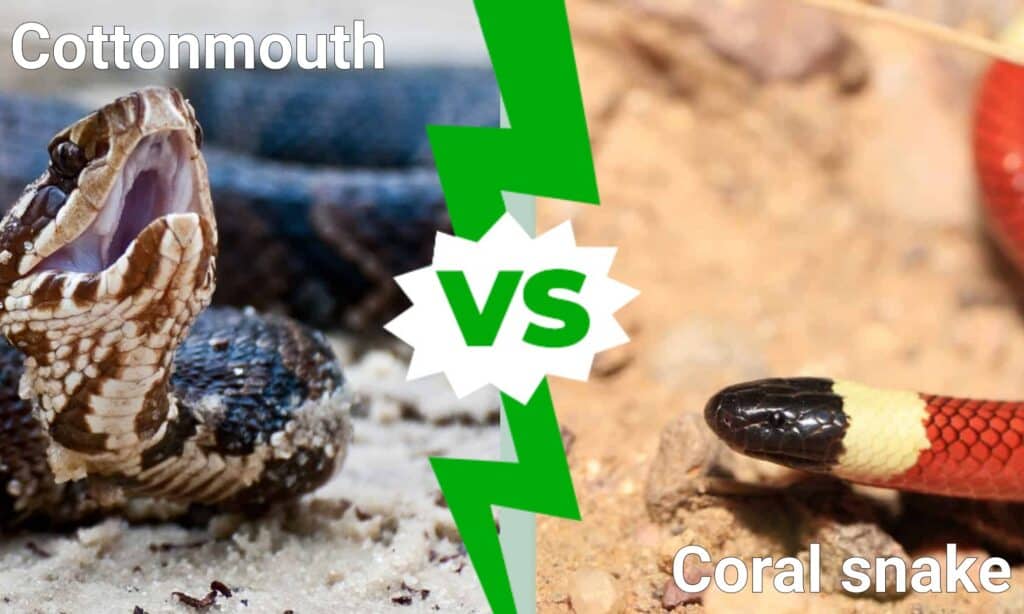Cottonmouths and coral snakes are two deadly snake species known to man. Both species are venomous and have claimed many lives. In this article, we’ll be placing these two deadly predators side by side to find out which is deadlier. Let’s jump right into it! Cottonmouth snake vs coral snake: which snake is more venomous?
Cottonmouth Snake (Agkistrodon piscivorus)

Measuring anywhere between 24 and 72 inches long, cottonmouths are pit vipers in the Viperidae family.
©KF2017/Shutterstock.com
Cottonmouths are pit vipers in the Viperidae family. They measure anywhere between 24 inches to 72 inches. Cottonmouth snakes are usually black with markings over their body and head. They also have crossbands across their whole bodies.
Coral Snake (Micrurus)

Coral Snakes (Micrurus) are elapid snakes.
©iStock.com/JasonOndreicka
Coral snakes are a group of elapid snakes. There are over 80 species of coral snakes divided into two groups: new-world elapid snakes and old-world elapid snakes. They measure anywhere from 24 to 60 inches. Coral snakes are colorful and have red, black, or yellow and white coloring.
Cottonmouth Snake Venom vs Coral Snake Venom

Cottonmouth Snake Venom
Cottonmouth snakes venom contains hemotoxins that break down blood cells and stop blood from clotting. Their maximum venom yield is 237 mg. Andrew H. Price, researcher, and herpetologist working in natural resource management for Texas Parks published his book “Venomous Snakes of Texas: A Field Guide” which researched the cottonmouth venom. He approximated that the human lethal dose is about 100–150 mg. This means that a cottonmouth’s venom could be strong enough to kill two humans.
Coral Snake Venom
Coral snakes have a very wide range of venom potency and yield. We’ll consider the eastern coral snake, one of the deadliest coral snakes.
The coral snake’s venom contains neurotoxins that cause paralysis and respiratory failure. According to Dr. Peterson, an instructor at Oregon State University College of Veterinary Medicine in Corvallis, Oregon, and a staff veterinarian at Reid Veterinary Hospital, Albany, Oregon, eastern coral snakes maximum venom yield is 20 mg. The human lethal dose of the coral snake venom is 4-5 mg. Consequently, a coral snake has venom that is strong enough to kill 5 humans.
Cottonmouth Snake Fangs
Like all pit vipers, cottonmouths have solenoglyphous fangs. They are hollow, foldable, and designed to inject venom as deeply as possible. They transmit venom from the snakes into their prey faster than any other fang. Their long and hollow forms help them lock their victims in their jaws long enough to bite and transmit the venom through openings in their teeth. Solenoglyphous fangs create deep wounds which allow the venom to get even deeper into their prey.
Coral Snake Fangs
Coral snakes have proteroglyphous fangs which are about a third of solenoglyphous fangs in length. They cannot be extended or moved but some snakes with this type of fang emit venom at higher speeds. Snakes with proteroglyphous fangs can also have more than one fang in their tooth pockets. This allows them to hold on to their prey tightly and inject more venom into them.
Cottonmouth Snake vs Coral Snake: Which Snake is More Venomous?
Considering the maximum venom yield as well as the human lethal dose, a coral snake is more venomous than a cottonmouth snake.
Although coral snakes are more venomous than cottonmouths, they can not deliver an ample amount of venom in a bite.
The mortality rate for coral snake bites is around 10%. The first documented death since the 1960s caused by a coral snake was reported over ten years ago. Following the bite of an eastern coral snake, the victim failed to seek medical help and, as a result, died.
Cottonmouths have an average venom yield of 125 mg. According to research scientist Henry M. Parrish’s article published in 1967, the mortality rate for cottonmouth snake bites is less than 1% (around 0.01%).
Cottonmouth and Coral Snake Bite Death Statistics
- An average of 7,500 people are bitten by snakes in the US each year.
- Coral snakes hardly bite. They are responsible for less than 2% of all snake bites in the USA. This means that an average of 150 coral snake bite cases are reported each year.
- According to the Texas Parks and Wildlife Department, cottonmouths account for less than 1% of all snakebite deaths in the U.S.
- Only about 0.2% of all venomous snakebites result in death (1 in 500 bites result in death).
- On average, half of all venomous snakebites are dry bites. This means that no venom was injected.
Cottonmouth Snake Temperament vs Coral Snake Temperament
Coral snakes are known to be recluses. They are nocturnal snakes with shy personalities. They avoid being seen and spotted. Cottonmouths are known to stand their ground when confronted. However, they do not bite unless they feel threatened.
What To Do If You Get Bitten By A Cottonmouth Or Coral Snake
Quite a large portion of the reported snakebite deaths occur because there was a delay in seeking medical help. If you are bitten by a snake, seek medical help immediately. It’ll help if you can identify or describe the snake that bit you. However, if you can’t, give medical staff as precise a location on where it happened so doctors can figure out which species bit you.
Here are some of the major don’ts if you get bitten by a snake.
- Do not delay in seeking medical attention.
- Do not attempt to suck out the venom.
- Do not chop off the bitten part. Snake bites can be treated with anti-venom. Cutting off a part of your body will cause you to lose blood among a host of other problems that could kill you faster than a snake bite.
- Do not move around. If venom has been injected into you, moving around will only help it circulate faster. Sit still and wait for professional help.
The photo featured at the top of this post is ©
Discover the "Monster" Snake 5X Bigger than an Anaconda
Every day A-Z Animals sends out some of the most incredible facts in the world from our free newsletter. Want to discover the 10 most beautiful snakes in the world, a "snake island" where you're never more than 3 feet from danger, or a "monster" snake 5X larger than an anaconda? Then sign up right now and you'll start receiving our daily newsletter absolutely free.
Thank you for reading! Have some feedback for us? Contact the AZ Animals editorial team.






